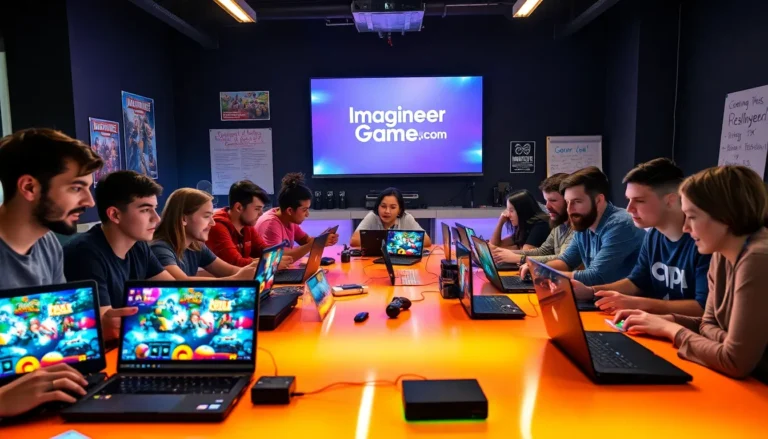In today’s competitive job market, understanding recruitment trends is essential for organizations aiming to attract top talent. With rapid changes in technology and workforce dynamics, companies must adapt their strategies to stay ahead. Recruitment insights provide valuable data that can refine hiring processes and enhance candidate experiences.
Employers are increasingly turning to analytics and innovative approaches to streamline recruitment and improve outcomes. By leveraging these insights, companies can make informed decisions that not only fill positions but also build cohesive teams aligned with their goals. This article explores key recruitment insights that can transform hiring strategies and drive organizational success.
Table of Contents
ToggleUnderstanding Recruitment Insights
Recruitment insights encompass data-driven observations that organizations gather to enhance their hiring processes. These insights inform employers about effective practices, candidate preferences, and overall market trends.
What Are Recruitment Insights?
Recruitment insights consist of metrics and analysis that illuminate hiring patterns and candidate behaviors. These include:
- Candidate Experience Metrics: Feedback and satisfaction ratings from applicants regarding the hiring process.
- Time-to-Hire: The duration between job posting and candidate acceptance, reflecting recruitment efficiency.
- Source of Hire: Data indicating which recruitment channels yield the best candidates.
- Diversity Metrics: Analysis of candidate demographics to ensure equitable hiring practices.
- Attrition Rates: Information on employee turnover that helps in evaluating the effectiveness of the recruitment strategy.
These insights guide employers in making informed decisions about refining their recruitment approaches.
Importance of Recruitment Insights in Hiring
Recruitment insights play a critical role in shaping effective hiring strategies. Key benefits include:
- Enhanced Decision-Making: Data-backed insights enable teams to identify successful recruitment methods.
- Targeted Talent Acquisition: Understanding candidate preferences helps in customizing outreach efforts.
- Improved Candidate Quality: Metrics reveal the traits of top-performing candidates, aiding in more effective selection.
- Streamlined Processes: Insights from time-to-hire and source of hire data highlight areas for optimizing recruitment workflows.
- Diversity and Inclusion: Evaluating diversity metrics fosters inclusive hiring practices, contributing to a balanced workforce.
Utilizing these insights ensures organizations remain competitive by attracting and retaining the right talent.
Key Trends in Recruitment

Organizations increasingly rely on trends that shape effective hiring strategies in a competitive job market. Understanding these trends is crucial for adapting recruitment methods to meet evolving workforce demands.
Data-Driven Recruitment
Data-driven recruitment refers to using analytics to inform hiring decisions. This approach helps organizations track important metrics such as:
- Candidate experience ratings: Organizations gather feedback to enhance overall applicant satisfaction.
- Time-to-hire: Analyzing hiring timelines uncovers bottlenecks in the recruitment process.
- Source of hire: Identifying which channels deliver the best candidates allows for targeted sourcing.
- Diversity metrics: Evaluating diversity in candidate pools supports inclusive hiring practices.
- Attrition rates: Monitoring turnover helps improve retention strategies.
By utilizing data analytics, employers make informed decisions that enhance their recruitment strategies and lead to better talent acquisition.
The Role of AI in Recruitment Insights
AI technology transforms recruitment insights by automating data analysis and streamlining processes. Key functions of AI in recruitment include:
- Resume screening: AI algorithms quickly filter resumes based on predefined criteria, saving time and energy.
- Predictive analytics: AI predicts candidate suitability by analyzing historical data, leading to more accurate hiring.
- Chatbots: AI-driven chatbots engage with candidates, answering queries and scheduling interviews.
- Bias reduction: AI tools help organizations identify and eliminate bias in hiring decisions, promoting diversity.
Incorporating AI into recruitment enhances efficiency, improves candidate experiences, and optimizes decision-making. Organizations that leverage these technologies maintain a competitive edge in attracting top talent.
Challenges in Implementing Recruitment Insights
Organizations face several challenges when implementing recruitment insights, including data privacy concerns and bias in hiring processes.
Overcoming Data Privacy Concerns
Organizations must navigate strict data privacy regulations, such as the General Data Protection Regulation (GDPR) and the California Consumer Privacy Act (CCPA). Compliance with these laws requires transparent data collection methods. Organizations should implement consent-based approaches when gathering candidate information. They must ensure secure storage of sensitive data and conduct regular audits to identify potential vulnerabilities. Establishing clear data usage policies builds trust with candidates while protecting both parties legally.
Addressing Bias in Hiring Processes
Bias in hiring processes can undermine the effectiveness of recruitment insights. Organizations must examine their recruitment data for patterns indicating bias against specific candidate groups. Developing training programs focused on bias awareness is crucial. Implementing standardized evaluation criteria helps create a level playing field for all candidates. Utilizing AI-driven tools can also help identify and mitigate bias in job descriptions and candidate evaluations, promoting a fairer recruitment process. By continuously monitoring and adjusting these practices, organizations reinforce their commitment to diversity and inclusion.
Best Practices for Utilizing Recruitment Insights
Organizations can enhance their hiring strategies by effectively utilizing recruitment insights. Implementing best practices allows for better decision-making and improved candidate experiences.
Leveraging Analytics for Better Hiring Decisions
Organizations can benefit from tracking key recruitment metrics. Examples include candidate experience ratings, source of hire effectiveness, and diversity statistics. By analyzing these data points, hiring managers can make informed decisions that align with organizational goals. Utilizing predictive analytics also enables organizations to identify trends and improve the quality of hires over time. Integrating analytics into recruitment software simplifies the monitoring process, ensuring real-time data access for optimizing strategies.
Continuous Improvement Through Feedback Loops
Feedback loops play a crucial role in refining recruitment processes. Organizations can gather feedback from candidates and hiring teams after each hiring event. Using surveys to assess candidate experience helps identify areas for improvement. Additionally, analyzing the feedback allows for adjustments in sourcing methods, interview styles, and onboarding procedures. Regularly revisiting these insights and making iterative changes ensures that recruitment practices evolve alongside workforce demands and expectations. This continuous improvement fosters a culture of responsiveness and agility in talent acquisition efforts.
Future of Recruitment Insights
Organizations continuously adapt their recruitment strategies to stay aligned with future trends. Understanding emerging technologies and their impacts on recruitment proves essential for businesses aiming to enhance their talent acquisition processes.
Emerging Technologies and Their Impact
Emerging technologies reshape recruitment by streamlining processes and enhancing decision-making. Organizations increasingly adopt tools like artificial intelligence (AI), machine learning, and automation to improve hiring practices. AI-driven platforms streamline resume screening, enabling faster evaluation of candidates. Automation assists in scheduling interviews, reducing administrative burdens.
Additionally, video interviewing software gained popularity, allowing organizations to assess candidates remotely. These technologies foster a more agile hiring process, enabling real-time adjustments based on data insights. Organizations leveraging chatbots improve candidate engagement, providing instant responses to inquiries. Such engagement enhances the candidate experience, which directly influences recruitment success.
Predictions for Recruitment Trends
Recruitment trends suggest a shift towards a more candidate-centric approach. Emphasis on personal branding, organizational culture, and flexibility will shape recruitment strategies. Skills-based hiring continues to gain ground, prioritizing a candidate’s abilities over traditional qualifications.
Data analytics will drive future recruitment strategies, offering deeper insights into candidate behavior and preferences. Employers will focus on diverse talent pools, ensuring inclusivity and representation. Remote work will remain prevalent, prompting organizations to expand their search beyond geographical limitations.
As recruitment evolves, organizations must remain vigilant. Continuous adaptation to emerging technologies and trends will enhance recruitment strategies, ensuring they attract and retain top talent.
Staying ahead in recruitment requires a proactive approach to evolving trends and technologies. Organizations that effectively leverage recruitment insights are better positioned to attract and retain top talent. By utilizing data analytics and AI, they can streamline processes and enhance candidate experiences.
Continuous improvement through feedback and monitoring ensures that hiring strategies remain relevant and effective. As the landscape shifts toward a more candidate-centric focus, embracing these insights will foster inclusivity and representation.
Organizations must commit to adapting their recruitment practices to meet the demands of a dynamic workforce. This commitment not only strengthens hiring outcomes but also contributes to long-term organizational success.



